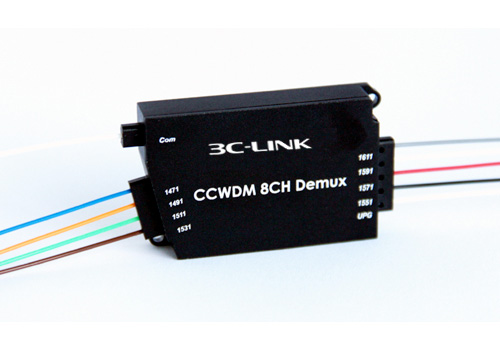
CCWDM Module
The DRA (Distributed Raman Amplifier) Raman Optical Amplifier Card launched by 3C-LINK utilizes the Raman scattering effect in the quartz fiber to provide gain to the optical signal. Adopting 14xxnm wavelength laser as Raman pumping, it provides gain to C-band signal light, which can effectively compensate for the attenuation of optical signal in fiber long-distance transmission to extend the power budget of optical link and significantly improve OSNR, suitable for long-distance optical transmission system.
Raman optical amplifier allows signal amplification at any wavelength. The working principle is based on stimulated Raman scattering (SRS). Undoped optical fiber is used. The photon that is inserted excites the electron and it goes into a vibrating state. Then, the stimulated emission occurs when the electron de-excites to the vibrational state of the glass molecules in the optical fibe
| Model | 3C-ONC-DRA | ||||
| Parameter | Minimum | Normal Value | Maximum | Unit | Remark |
| Working wavelength | 1528 | 1565 | nm | ||
| Input optical power | -36 | -10 | dBm | ||
| Effective gain | 12 | 14 | 15 | dB | @G.652 optical fiber > 40km, attenuation coefficient 0.20dB/km |
| Gain flatness | 2.2 | dB | @Gain=14 | ||
| Pump wavelength | 1423~1465 | nm | |||
| Total pump output power | 700 | mw | @Each pump can be set to 500mw, 2 pumps in total | ||
| Noise figure | 0 | dB | |||
| Input optical power threshold | -38 | dBm | Configurable | ||
| Number of slots occupied | Support all 3C-OTNS8600 series chassis, occupies 2 slots | ||||

| Model | 3C-ONC-BDRA | ||||
| Parameter | Minimum | Normal Value | Maximum | Unit | Remark |
| Working Wavelength | 1528 | 1565 | nm | ||
| Input optical power | 0 | 14 | dBm | ||
| Effective gain | 10 | dB | @G.652 optical fiber > 40km attenuation coefficient 0.20dB/km | ||
| @Input optical power = 14dBm | |||||
| Gain fatness | 2.2 | dB | @Gain=14 | ||
| Pump wavelength | 1423~1465 | nm | |||
| Total pump output power | 700 | mw | @Each pump can be set to 500mw | ||
| Total 2 pumps | |||||
| Noise figure | 0 | dB | |||
| Input optical power threshold | 0 | dBm | Configurable | ||
| Number of slots occupied | Support all 3C-OTNS8600 series chassis, occupies 2 slots | ||||
| Features | EDFA | Raman amplifier |
| Working principle | It uses stimulated radiation of EDF fibers to amplify optical signals.
It requires doped optical fiber. |
It uses stimulated Raman scattering for the amplification of optical signals.
It does not require doped optical fiber. |
| Pump power | 25 dBm | > 30 dBm |
| Amplification band | 1525 nm – 1565 nm and
1570 nm – 1610 nm. |
All wavelengths |
| Noise figure | 5 dB | 5 dB |
| Gain | > 40 dB | > 25 dB,
gain is smaller than EDFA, for about 5 –15 dB |
| Cost factor | Low | High |
3CF-SFP+-SRP
3CPG-434S1OM-LX
3CW-QSFP28-23-LR& 3CW-QSFP28-32-LR
3C-56GB-CU1M
3CI-SFP0204G
3C-ONTS8600I-OLS
3C-HDMI-M4K60-T10
3C-ONU-X100W
3C-XM100DG
3C-AD-SCU

Copyright © 2022 3c-link Corporation Limited.VOKO提供网站技术支持
Privacy Policy